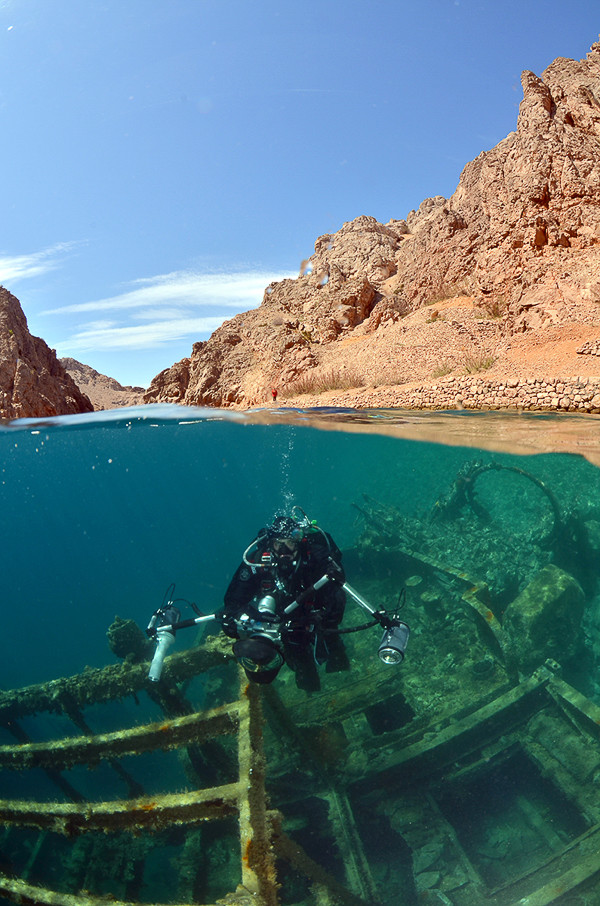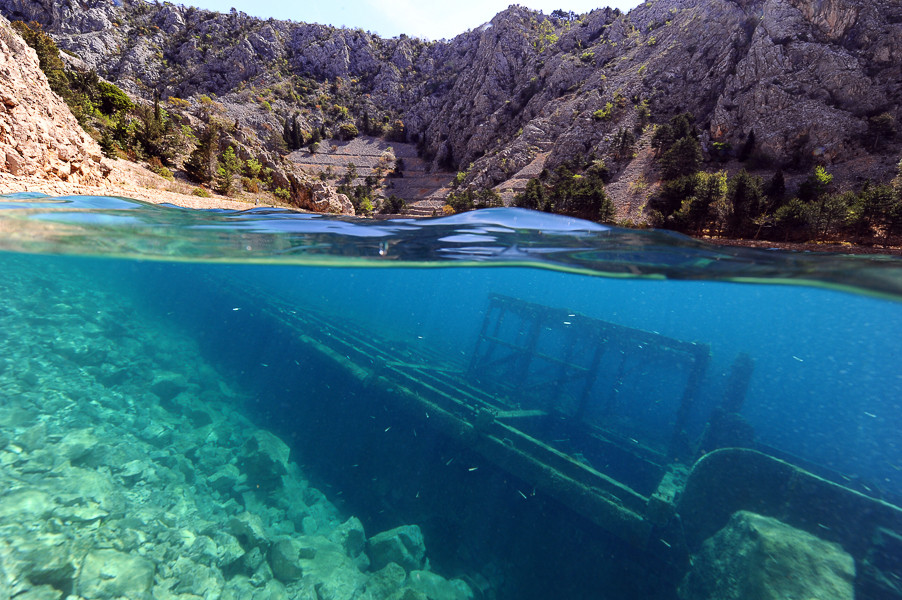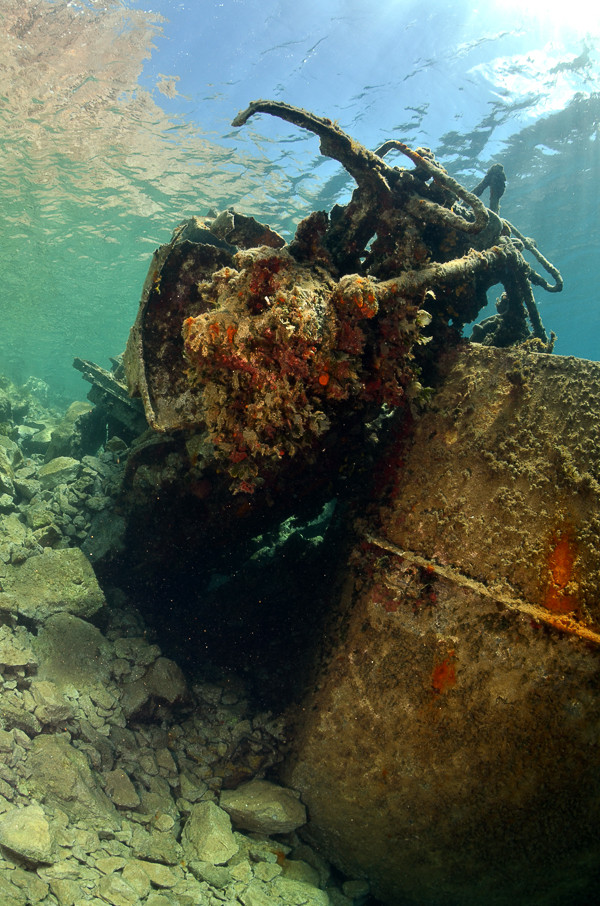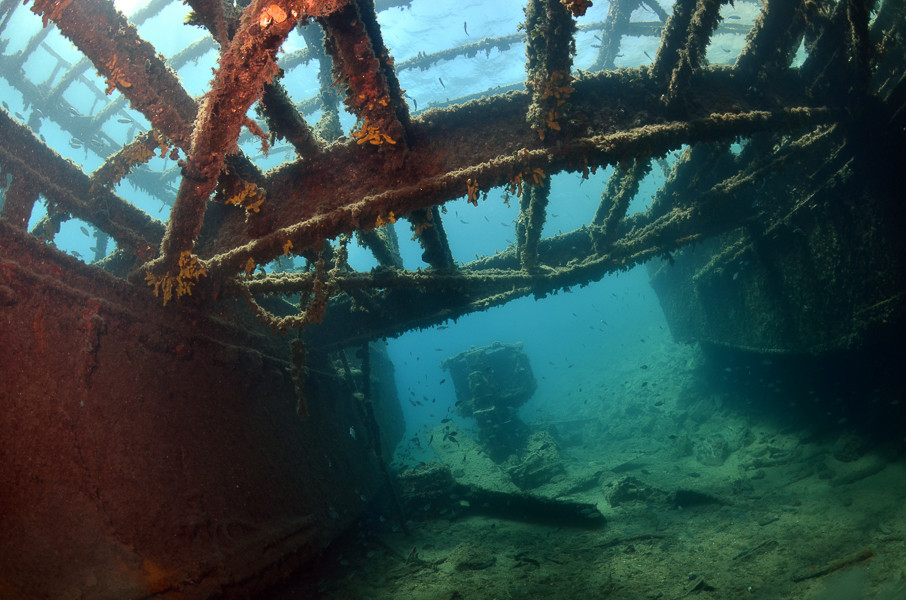
LANDING BARGE LF 126
DEPTH: 1 - 10 m
SKILL: Beginner
LF 126; Pionierlandungsfähre 41 (PiLF 41); twin-hulled landing barge (Siebelfähre); 1/Ldgs.Pi.Btl. 771st engineer battalion
Built: Siebel, Germany
Sunk: 25th August 1944 (attacked by British Hurricane fighter-bomber)
Dimensions: l=24.3 m, w=13.9 m
Coordinates: 44.70022° N, 14.90218° E
Location: in the Bay of Zavratnica
Access: 4/5 access is possible by boat and from the land, there is a footpath from Jablanac (about 1,200 m)
Visibility: 5/5 mostly clear and good visibility
Current: 5/5 no current
Flora and fauna: 3/5 varied life on and around the wreck, only small specimens
HISTORY:
Siebelfähre (the Siebel ferry) is the German title for a prefabricated twin-hulled landing craft which was used by the German Army (Wehrmacht) as well as the German Navy (Kriegsmarine) and at the beginning of the Second World War. Since they were looking for an urgent solution for the sea transportation of great numbers of people and material, Wilhelm Siebel had the idea of connecting pontoons and advance bridges with flat platforms in one single vessel, which would be powered by aircraft engines.
After the Germans aborted Operation Sea Lion, the twin-hulled barges were deployed over many battle fronts, amongst which were the Black and Mediterranean seas. Thanks to their modular construction, they could be quickly transported by rail to distant war zones. The barges were particularly present in operations in the Mediterranean, where besides transport roles and mine laying, they also had the roles of landing craft.
After the war, surviving examples were used in many countries as means of conveyance and transport. On the River Rhine, in the region of Bonn and Nierstein, and especially on the Adriatic, twin-hulled barges were used as ferries right up until the mid-1960’s.
The narrow and deep Bay of Zavratnica near Jablanac was used by the Germans during the Second World War as a suitable shelter for German landing boats which carried coastal traffic. It was especially intense during 1944, when the Partisans practically paralysed all land transport. Therefore the Germans left all the major transport of material and soldiers to be carried by sea. Since the Allied air forces had achieved complete air supremacy at the beginning of 1944, the Germans avoided any sailing during the day when they could be attacked from the air. Along Croatia’s coast they set up a series of shelters in deep and hidden coves where the ships would spend the day waiting for the evening, when they could continue their journeys. Zavratnica was a well fortified cove, however Allied fighter-bombers located them and during the day would attack them as soon as they had the chance.
Zavratnica was an especially risky place to attack due to its very narrow and steep slopes of the surrounding hills, so the German defence succeeded on two occasions to shoot down British aeroplanes. However the German losses were also great, in Zavratnica itself, during the war, about ten various small ships and boats were sunk. Such a fate also awaited the twin-hulled barge the LF 126 which along with another barge the LF 122 was sheltering in Zavratnica on 25th August 1944. In an attack by British Hurricanes both barges were showered with salvos from five aeroplanes, which attacked them in two waves. The LF 126 received hits in both hulls and caught fire. Although the other ships tired to take it in tow, the barge, due to its sustained damage, sank in the cove directly along the shore, where it lies today.
WRECK CONDITION AND DIVING:
The wreck of the twin-hulled barge LF 126 lies in the cove of Zavratnica, one of the most beautiful in the Adriatic. The wreck is located about 800 metres from the entrance to the cove on a shallow bottom immediately next to the northern shore. From the footpath that runs alongside the whole of the northern shore of the bay, the wreck can easily be seen during calm weather. During low tides its tallest part can even be seen protruding above the sea’s surface. The sea in Zavratnica is almost always very clear, except for the hot summer months when visibility is somewhat reduced. The wreck lies parallel with the shore, with its front section turned towards the bottom of the cove. We can also dive from the shore and see the whole of the wreck in the crystal clear sea.
The left pontoon is shallow and rests on a rocky slope at just three metres deep, whilst the right pontoon leans on the sandy bottom. Each pontoon is actually a separate vessel composed of several cubed sections with a square-like bow and tapered stern.
Today the cabins are half full of silt. One of the engines is still in situ, whilst the other was removed long ago. In the centre of the aft section was once located a superstructure with the crew’s rooms and wheelhouse. This was completely burnt in the fire and from it there only remains a steel skeleton.
Diving under the platform towards the bow we come across various remains of debris which was surely once the cargo of German ships. If we dive away from the wreck towards the middle of the cove, in many places we will find the remnants of the battle – cannon shells, ammunition of various calibres, and even unexploded rockets from the British fighters which missed their target. You must not touch any kind of munitions left over from the war, since their explosives, even after fifty or so years, can still be very dangerous.
Being that Zavratnica is a narrow cove, when we dive from the middle of the cove towards the entrance, when both sides of the shore can be seen, this is a special experience. Many years ago in the centre of the cove at about twenty metres deep we found the remains of the left wing of a British Hurricane fighter.
Due to the low depth, after we have viewed the wreck of the barge we can carry on towards the exit of the cove, where the depth does not exceed 25 metres, and where the visibility is excellent everywhere. On both sides of the exit the underwater reefs are very picturesque which are at least worth a visit. The bottom here drops steeply to greater depths, but as information exists that Allied aircraft sank some smaller boats in front of the entrance to the bay during the Second World War, a detailed investigation will have to be left for another opportunity.
The description and illustrations are a courtesy of Danijel Frka and Jasen Mesić. Buy the whole book here: https://shop.naklada-val.hr/product_info.php?products_id=561
Built: Siebel, Germany
Sunk: 25th August 1944 (attacked by British Hurricane fighter-bomber)
Dimensions: l=24.3 m, w=13.9 m
Coordinates: 44.70022° N, 14.90218° E
Location: in the Bay of Zavratnica
Access: 4/5 access is possible by boat and from the land, there is a footpath from Jablanac (about 1,200 m)
Visibility: 5/5 mostly clear and good visibility
Current: 5/5 no current
Flora and fauna: 3/5 varied life on and around the wreck, only small specimens
HISTORY:
Siebelfähre (the Siebel ferry) is the German title for a prefabricated twin-hulled landing craft which was used by the German Army (Wehrmacht) as well as the German Navy (Kriegsmarine) and at the beginning of the Second World War. Since they were looking for an urgent solution for the sea transportation of great numbers of people and material, Wilhelm Siebel had the idea of connecting pontoons and advance bridges with flat platforms in one single vessel, which would be powered by aircraft engines.
After the Germans aborted Operation Sea Lion, the twin-hulled barges were deployed over many battle fronts, amongst which were the Black and Mediterranean seas. Thanks to their modular construction, they could be quickly transported by rail to distant war zones. The barges were particularly present in operations in the Mediterranean, where besides transport roles and mine laying, they also had the roles of landing craft.
After the war, surviving examples were used in many countries as means of conveyance and transport. On the River Rhine, in the region of Bonn and Nierstein, and especially on the Adriatic, twin-hulled barges were used as ferries right up until the mid-1960’s.
The narrow and deep Bay of Zavratnica near Jablanac was used by the Germans during the Second World War as a suitable shelter for German landing boats which carried coastal traffic. It was especially intense during 1944, when the Partisans practically paralysed all land transport. Therefore the Germans left all the major transport of material and soldiers to be carried by sea. Since the Allied air forces had achieved complete air supremacy at the beginning of 1944, the Germans avoided any sailing during the day when they could be attacked from the air. Along Croatia’s coast they set up a series of shelters in deep and hidden coves where the ships would spend the day waiting for the evening, when they could continue their journeys. Zavratnica was a well fortified cove, however Allied fighter-bombers located them and during the day would attack them as soon as they had the chance.
Zavratnica was an especially risky place to attack due to its very narrow and steep slopes of the surrounding hills, so the German defence succeeded on two occasions to shoot down British aeroplanes. However the German losses were also great, in Zavratnica itself, during the war, about ten various small ships and boats were sunk. Such a fate also awaited the twin-hulled barge the LF 126 which along with another barge the LF 122 was sheltering in Zavratnica on 25th August 1944. In an attack by British Hurricanes both barges were showered with salvos from five aeroplanes, which attacked them in two waves. The LF 126 received hits in both hulls and caught fire. Although the other ships tired to take it in tow, the barge, due to its sustained damage, sank in the cove directly along the shore, where it lies today.
WRECK CONDITION AND DIVING:
The wreck of the twin-hulled barge LF 126 lies in the cove of Zavratnica, one of the most beautiful in the Adriatic. The wreck is located about 800 metres from the entrance to the cove on a shallow bottom immediately next to the northern shore. From the footpath that runs alongside the whole of the northern shore of the bay, the wreck can easily be seen during calm weather. During low tides its tallest part can even be seen protruding above the sea’s surface. The sea in Zavratnica is almost always very clear, except for the hot summer months when visibility is somewhat reduced. The wreck lies parallel with the shore, with its front section turned towards the bottom of the cove. We can also dive from the shore and see the whole of the wreck in the crystal clear sea.
The left pontoon is shallow and rests on a rocky slope at just three metres deep, whilst the right pontoon leans on the sandy bottom. Each pontoon is actually a separate vessel composed of several cubed sections with a square-like bow and tapered stern.
Today the cabins are half full of silt. One of the engines is still in situ, whilst the other was removed long ago. In the centre of the aft section was once located a superstructure with the crew’s rooms and wheelhouse. This was completely burnt in the fire and from it there only remains a steel skeleton.
Diving under the platform towards the bow we come across various remains of debris which was surely once the cargo of German ships. If we dive away from the wreck towards the middle of the cove, in many places we will find the remnants of the battle – cannon shells, ammunition of various calibres, and even unexploded rockets from the British fighters which missed their target. You must not touch any kind of munitions left over from the war, since their explosives, even after fifty or so years, can still be very dangerous.
Being that Zavratnica is a narrow cove, when we dive from the middle of the cove towards the entrance, when both sides of the shore can be seen, this is a special experience. Many years ago in the centre of the cove at about twenty metres deep we found the remains of the left wing of a British Hurricane fighter.
Due to the low depth, after we have viewed the wreck of the barge we can carry on towards the exit of the cove, where the depth does not exceed 25 metres, and where the visibility is excellent everywhere. On both sides of the exit the underwater reefs are very picturesque which are at least worth a visit. The bottom here drops steeply to greater depths, but as information exists that Allied aircraft sank some smaller boats in front of the entrance to the bay during the Second World War, a detailed investigation will have to be left for another opportunity.
The description and illustrations are a courtesy of Danijel Frka and Jasen Mesić. Buy the whole book here: https://shop.naklada-val.hr/product_info.php?products_id=561








 The investment is co-financed by the Republic of Slovenia and the European Union from the European Regional Development Fund.
The investment is co-financed by the Republic of Slovenia and the European Union from the European Regional Development Fund.  H2O Globe BETA
H2O Globe BETA